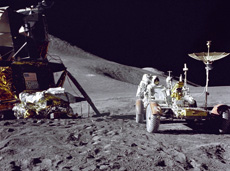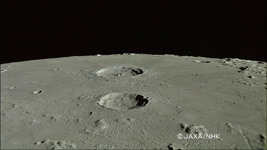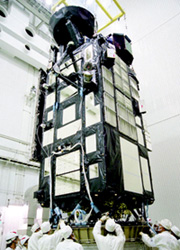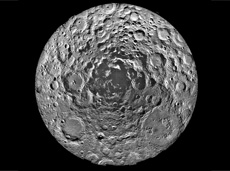
Q. What is the purpose of launching the lunar probe KAGUYA?

Apollo 15. Throughout the Apollo mission, a total of 12 astronauts landed on the Moon. (courtesy: NASA)
I have been interested in the origin and evolution of the Moon and planets for a long time. I was a student when Apollo 11 landed on the Moon, and I still vividly remember the event. I didn't know much about the details of the mission, but I was so curious about this venture to the Moon I couldn't keep my eyes off the TV. The Apollo mission turned the Moon into a subject of scientific research. Over the course of the mission, 12 astronauts in total landed on the Moon to carry out scientific exploration, and they always returned to Earth with many discoveries. To my mind, the Apollo mission set the ultimate example for planetary exploration. It also taught us how to observe planets more closely.
It has been 40 years since Apollo, and in that time scientific instruments have vastly improved. We thought it was time for us to apply what we had learned from the mission and probe the Moon ourselves. We were sure there would be many new discoveries if we used cutting-edge technology to globally observe the Moon. This is how we decided to launch KAGUYA.
It has been 40 years since Apollo, and in that time scientific instruments have vastly improved. We thought it was time for us to apply what we had learned from the mission and probe the Moon ourselves. We were sure there would be many new discoveries if we used cutting-edge technology to globally observe the Moon. This is how we decided to launch KAGUYA.
Q. What can studying the Moon teach us?

The Moon and the Earth (courtesy: NASA)
The giant-impact hypothesis is currently the most potent explanation for the origin of the Moon. It suggests that a Mars-sized body obliquely impacted the Earth shortly after its birth, about 4.6 billion years ago, and that the scattered materials coalesced and formed the Moon. In that sense the Moon and the Earth are a pair, and for that reason I think it's very important to learn about the Moon to better understand our planet. I also believe that you cannot discover the origins of our solar system and other bodies without understanding the Moon. Once we investigate the Moon in detail and verify the giant-impact hypothesis, we will then look into Mars and Venus, or we will return our attention to Earth. Lunar exploration gives us great clues about our solar system as well as Earth.
In addition, ancient materials of Earth still exist on the Moon. Because Earth has an atmosphere, water, and volcanic activity, natural phenomena such as wind, rain and volcanism have eroded surface materials such as rocks over the millennia. As a result, no ancient materials remain on the surface. On the lunar surface, on the other hand, ancient materials still exist, because there is no atmosphere or water to cause weather phenomena, and volcanic activity ended long ago. So by studying the Moon, we can get a picture of the Earth 4 billion years ago.
In addition, ancient materials of Earth still exist on the Moon. Because Earth has an atmosphere, water, and volcanic activity, natural phenomena such as wind, rain and volcanism have eroded surface materials such as rocks over the millennia. As a result, no ancient materials remain on the surface. On the lunar surface, on the other hand, ancient materials still exist, because there is no atmosphere or water to cause weather phenomena, and volcanic activity ended long ago. So by studying the Moon, we can get a picture of the Earth 4 billion years ago.

Vicinity of Apollo 15 landing site, imaged by KAGUYA's high-definition camera
Q. What is the area of lunar research you are most interested in?
I would like to better understand the material composition and structure of the Moon, including both the surface and the interior. I think this is going to be quite challenging, since we have not yet even fully understood the interior structure of the Earth. However, understanding the material composition of the Moon is the priority. It is an essential step in furthering our understanding of the formation and evolution of materials. From that point of view, KAGUYA still presents an early phase, because it's only observing the surface materials from orbit.
I would like to better understand the material composition and structure of the Moon, including both the surface and the interior. I think this is going to be quite challenging, since we have not yet even fully understood the interior structure of the Earth. However, understanding the material composition of the Moon is the priority. It is an essential step in furthering our understanding of the formation and evolution of materials. From that point of view, KAGUYA still presents an early phase, because it's only observing the surface materials from orbit.

Lunar explorer KAGUYA
KAGUYA consists of a main satellite and two small subsatellites, and is equipped with 14 scientific instruments. The mission is the fruit of Japan's cutting-edge technology. The onboard instruments are designed for several purposes: to study the surface rocks and their mineral composition; to map the topographic highs and lows on the surface; to investigate the subsurface structure to the depth of several kilometers; to determine lunar gravity (KAGUYA is the first probe to perform detailed observations of the gravitational fields on the lunar farside); to measure the lunar environment, such as magnetism and plasma around the Moon; to observe the Earth from the Moon; and to observe celestial bodies from the lunar farside.
KAGUYA is also equipped with a high-definition camera. Its high-resolution moving images of the Earth and the Moon were distributed around the world, and have been much talked about since then. I think the videos were very effective in demonstrating the excitement of science to many young people.
* Click here for a list of the scientific instruments.
Q. How is KAGUYA's data different from data acquired by earlier lunar explorers such as the three U.S. missions – Apollo, Clementine and Lunar Prospector?

Lunar South Pole observed by Clementine (courtesy: NASA)
KAGUYA is observing the Moon globally while the Apollo mission, carried out in the 1960s and early 1970s, studied just the vicinity of the lander of lunar nearside. Yet the Apollo mission made great contributions to our understanding of the Moon, by achieving the first human landing on the Moon, and also by returning rock and sand samples to Earth.
The Clementine mission was launched in 1994 to study the materials and topography of almost the entire lunar surface. The mission showed us the exciting possibilities of global observation of the Moon. It also made a great discovery that suggested the possible existence of water ice on a crater floor in a polar region. To further investigate this discovery, Lunar Prospector was launched in 1998, to observe the distribution of element composition and gravity fields on the nearside as well as in the polar regions. Although the spacecraft could not verify the existence of water in the polar regions, it still obtained valuable data.
Each mission obtained wonderful results, so I cannot simply compare them to KAGUYA. Having said that though, the precision of KAGUYA's scientific instruments is far greater than anything before it.
The Clementine mission was launched in 1994 to study the materials and topography of almost the entire lunar surface. The mission showed us the exciting possibilities of global observation of the Moon. It also made a great discovery that suggested the possible existence of water ice on a crater floor in a polar region. To further investigate this discovery, Lunar Prospector was launched in 1998, to observe the distribution of element composition and gravity fields on the nearside as well as in the polar regions. Although the spacecraft could not verify the existence of water in the polar regions, it still obtained valuable data.
Each mission obtained wonderful results, so I cannot simply compare them to KAGUYA. Having said that though, the precision of KAGUYA's scientific instruments is far greater than anything before it.